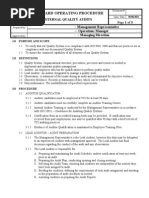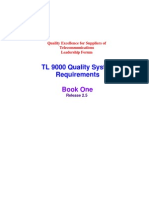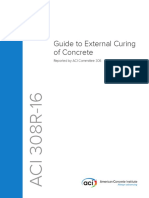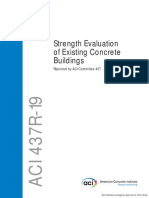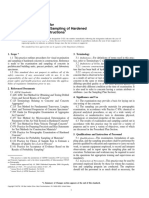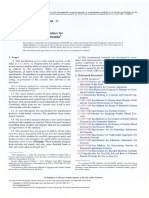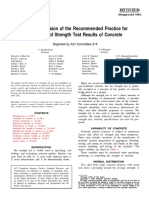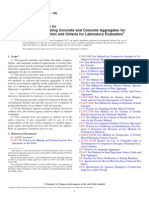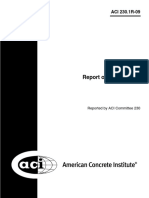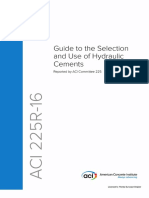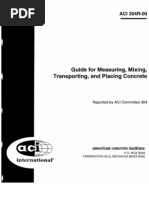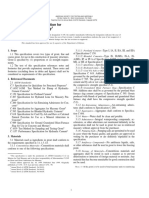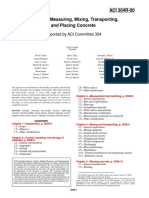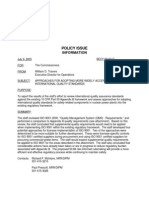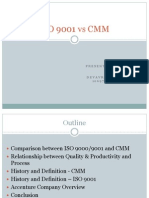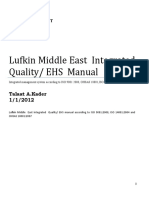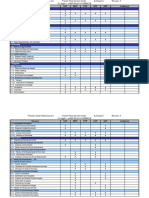Quality Management System For Concrete Construction: ACI 121R-04
Quality Management System For Concrete Construction: ACI 121R-04
Uploaded by
askarahCopyright:
Available Formats
Quality Management System For Concrete Construction: ACI 121R-04
Quality Management System For Concrete Construction: ACI 121R-04
Uploaded by
askarahOriginal Title
Copyright
Available Formats
Share this document
Did you find this document useful?
Is this content inappropriate?
Copyright:
Available Formats
Quality Management System For Concrete Construction: ACI 121R-04
Quality Management System For Concrete Construction: ACI 121R-04
Uploaded by
askarahCopyright:
Available Formats
ACI 121R-04
Quality Management System for
Concrete Construction
Reported by ACI Committee 121
Paul Zoltanetzky, Jr.
Chair
Jon B. Ardahl
Vice Chair
Paul Hedli
Secretary
Anthony R. Ameruso
Robert S. Jenkins
Gajanan M. Sabnis
Casimir Bognacki
H. P. Errol Lim
Johan C. Schor
Martin Brugger
Stephen Marchese
Roger D. Tate
Martin J. Fradua
Anand S. Mehta
Thomas G. Tyler
Alejandro Graf
Larry G. Mrazek
Woodward L. Vogt
Thomas M. Greene
Oon-Soo Ooi
Roger E. Wilson
C. Raymond
Hays*
*Led the task group that developed the 2003 revisions.
Note: Associate and Consulting Members who contributed to the development of this report: Morris V. Huffman, Godwin
Amekuedi, Paul D. Brooks, and Jack Holley.
This document provides guidance for the development and implementation
of quality systems for concrete construction projects. This document is
meant to be used by the architects/engineer and consultant communities
and specifically by owners, designers, and constructors of concrete construction
projects. A quality system involves the identification of quality objectives and
their incorporation into the quality plan, which is implemented by project
participants. A quality system allows user judgment with respect to
owners needs; defined quality objectives; project size, importance, and
complexity; and project organization skills.
This document follows the ANSI/ISO/ASQ Q9000 Series of Quality
Management Standards, which are similar to the auto industry QS 9000
Standards. The ANSI/ISO/ASQ Q9000 series is the American English
version of the ISO 9000 series. The ISO 9000 series is a standard for the
development of quality systems, published by the International Organization
ACI Committee Reports, Guides, Standard Practices, and
Commentaries are intended for guidance in planning,
designing, executing, and inspecting construction. This
document is intended for the use of individuals who are
competent to evaluate the significance and limitations of its
content and recommendations and who will accept
responsibility for the application of the material it contains.
The American Concrete Institute disclaims any and all
responsibility for the stated principles. The Institute shall not
be liable for any loss or damage arising therefrom.
Reference to this document shall not be made in contract
documents. If items found in this document are desired by the
Architect/Engineer to be a part of the contract documents, they
shall be restated in mandatory language for incorporation by
the Architect/Engineer.
It is the responsibility of the user of this document to
establish health and safety practices appropriate to the specific
circumstances involved with its use. ACI does not make any
representations with regard to health and safety issues and the
use of this document. The user must determine the
applicability of all regulatory limitations before applying the
document and must comply with all applicable laws and
regulations, including but not limited to, United States
Occupational Safety and Health Administration (OSHA)
health and safety standards.
for Standardization (ISO), established in Geneva, Switzerland. This agency
has representatives from more than 90 countries. The ISO 9000 series is
meant to be used by any organization anywhere in the world for the
development and implementation of quality systems for the manufacturing
and supply of products, the development and supply of services, or both.
Keywords: procedure; quality assurance; quality control.
CONTENTS
Chapter 1Introduction, p. 121R-2
1.1Scope and purpose
1.2Definitions
Chapter 2 Administrative aspects of a quality
system, p. 121R-3
2.1Responsibilities of the owner
2.2Characteristics of a quality system
2.3Initial project and preconstruction meetings
Chapter 3Quality plan, p. 121R-4
Chapter 4Quality manual, p. 121R-4
4.1Elements
4.2Responsibilities of the project team
4.3Quality policy
4.4Organization responsibilities
4.5Management representative
Chapter 5Quality manual elements, p. 121R-5
5.1Quality system procedures
ACI 121R-04 supersedes ACI 121R-98 and became effective September 19, 2004.
Copyright 2004, American Concrete Institute.
All rights reserved including rights of reproduction and use in any form or by any
means, including the making of copies by any photo process, or by electronic or
mechanical device, printed, written, or oral, or recording for sound or visual reproduction or for use in any knowledge or retrieval system or device, unless permission in
writing is obtained from the copyright proprietors.
121R-1
121R-2
ACI COMMITTEE REPORT
5.2Contract review
5.3Design control
5.4Document and data control
5.5Purchasing
5.6Control of owner-supplied product
5.7Product identification and traceability
5.8Process control
5.9Inspection and testing
5.10Control of measuring and test equipment
5.11Inspection and test status
5.12Control of nonconforming product
5.13Corrective and preventative action
5.14Handling and storage
5.15Control of quality records
5.16Audits
5.17Training
5.18Statistical techniques
Chapter 6References, p. 121R-7
6.1Referenced standards and reports
6.2Cited references
Appendix AQuality manual example, p. 121R-11
CHAPTER 1INTRODUCTION
1.1Scope and purpose
This document provides guidance for the development and
implementation of a quality system for concrete construction
projects. It is based on the ISO 9000-1994 Quality Systems
Standards requirements. With the exception of management
responsibility and servicing, all elements of ISO 9001 are
mentioned briefly. Where this document uses the word
should, the ISO standard uses shall, making these
requirements mandatory. This document does not establish
project work relationships. The project contract documents
define the owner/project team relationship and govern the
performance of these parties through the duration of the
project. This document is a management tool intended to
facilitate successful interaction among project team members.
This guide will accommodate projects that vary in size,
complexity, and number of organizations involved. On a
large project, all major organizations involved should
develop a quality plan with appropriate elements. On a small
project, a single overall quality plan and the contract documents can suffice.
Since the publication of ACI 121R-98, the ANSI/ISO/ASQ
Q9000-1994, which was the basis of the document, has been
revised. The latest revision is ANSI/ISO/ASQ Q9001-2000.
The 20 paragraphs have been restructured into five paragraphs.
The ANSI/ISO/ASQ Q9001-2000 standard now follows a
process approach. The process approach is a system methodology that recognizes that processes and their interactions are
the keys to establishing a quality management system.
The new standard (ANSI/ISO/ASQ ISO Q9001-2000)
consists of five interrelated elements that emphasize the
process approach. The new standard is driven by continual
improvement. They are: 4.0, Quality Management System; 5.0,
Management Responsibility; 6.0, Resource Management; 7.0,
Product Realization; and 8.0, Measurement, Analysis, and
Improvement. Exclusions are still permitted, for example, if you
do not do design, it can be excluded. More emphasis is placed
on the measurement, analysis, and improvement process.
The need to establish documented procedures has been
reduced to six specific references that are: 4.2.3, Control of
Documents; 4.2.4, Control of Records; 8.2.2, Internal Audit;
8.3, Control of Nonconforming Product; 8.5.2, Corrective
Action; and 8.5.3, Preventative Action. The organization can
rely on quality records to demonstrate that some action has
been completed.
A key terminology change from supplier to organization
when speaking of the firm seeking certification has been
implemented in ANSI/ISO/ASQ Q9001-2000. The term
suppliers is still used in ANSI/ISO/ASQ Q9001-2000. Its
meaning is now subcontractors to the organization. The
terminology used in ANSI/ISO/ASQ Q9001-2000 should
not be confused with the terminology used in ACI 121R-04.
The terminology used in ACI 121R-04 is different. Some
terms used in ANSI/ISO/ASQ Q9001-2000 have a meaning
different from that of terms used in ACI 121R-04. The terminology is defined in Section 1.2.
Whereas ANSI/ISO/ASQ Q9001-2000 has been reformatted,
the basic requirements of ANSI/ISO/ASQ Q9001-1994 are
now contained in Section 7.0 of the new standard.
The guidance contained in ACI 121R-04 provides the
owner with steps necessary to ensure development and
implementation of a successful quality system.
1.2Definitions
The definitions given in this section are taken from
American National Standards Institute/International
Organization for Standardization/American Society for
Quality (ANSI/ISO/ASQ) A8402.
contractora supplier in a contractual situation.
ownerthe organization that is responsible for the project
and the recipient of the product. The term encompasses the
agents of the owner, such as project/construction manager,
engineer, architect, quality consultant, and others, who have
been delegated some responsibility.
procedureA specified way of doing an activity.
Note:
In many cases, procedures are documented.
When a procedure is documented, the term written procedure or documented procedure is frequently used.
A written procedure usually contains the purpose and scope
of an activity; what shall be done and by whom; when,
where, and how it shall be done.
producta product is the result of activities or processes.
It may include service, hardware, processed materials,
software, or a combination thereof.
qualitythe totality of characteristics of an entity that
bear on its ability to satisfy stated and implied needs.
quality assurance (QA)actions taken by an organization
to provide and document assurance that what is being done
and what is being provided are in accordance with applicable
standards of good practice and follow the contract documents
for the work.
QUALITY MANAGEMENT SYSTEM FOR CONCRETE CONSTRUCTION
Table 2.1Elements of a quality system
Document
Contents
Owners policy statement
Quality objectives
Quality plan, Scope of work
Chapter 3 Organizational relationships
Authority/responsibilities of
various organizations
Quality
manual with
Elements,
Chapters
4 and 5
Elements applicable to that
organizations scope of work
Program
Implementing procedures
Organization responsible for
development of documents
Table 2.2Development of a quality system by
project phase and responsibilities
Project phase
Owner or designated
project manager
All organizations required
by the owner to develop a
quality manual
quality control (QC)actions taken by an organization
producing a product to provide control and documentation
over what is being done and what is being provided so that
the applicable standard of good practice and the contract
documents for the work are followed.
quality manuala document that states company policy
and describes the quality system of an organization.
quality planactivities that establish the objectives and
requirements for quality. It usually is project specific and
makes reference to the quality manual.
quality policyA statement of an organizations objectives
and commitment to quality.
quality systemthe organizational structure, responsibilities, procedures, processes, and resources needed to
ensure that an organizations quality objectives are met. As
used in this document, the quality system is spearheaded by
the owner and consists of the owners internal policies and
procedures for contracting, the (project) quality plan, and the
quality manuals implemented by the project team.
subcontractororganization that provides a product and
or service to a supplier.
supplierorganization that provides a product to the owner.
CHAPTER 2ADMINISTRATIVE ASPECTS
OF A QUALITY SYSTEM
2.1Responsibilities of the owner
The owner should be responsible for establishing the project
requirements before a project starts. Project requirements are
influenced by factors including available budget, function or
purpose, and desired service life. The owner should be
responsible for establishing a quality system, which includes
selecting competent organizations and individuals. If the owner
does not have the skills, personnel, or both, required to fulfill
these responsibilities, the owner should designate an organization or individual to perform these functions. Table 2.1
describes the elements of a quality system.
2.2Characteristics of a quality system
Table 2.2 indicates the various phases of a project and how
the quality system is developed. These phases represent the life
cycle of the project. The table also indicates responsibilities of
the organizations involved. It should be modified to fit the
specific organizational arrangements and quality objectives for
the project.
The quality system provides a framework for the information
flow between project organizations and interaction among
121R-3
Quality
system phase
Source of quality Responsible review
requirements or
organization and
reference guidance
action
Owner review and
Owner, project
approval is required
Owner*
Planning and
manager, consultant, if project quality
develops
definition of
engineer, and this plan was developed
requirements project quality
document
by another
plan
organization
Design
Designer
Owners project
develops
quality plan and this
quality manual
document
Owner, project
manager, or
Procurement both, develops
procurement
procedures
Owner, project
manager, designer,
contractor, and this
document
Owner or project
manager reviews
and approves
designer quality
manual
Owner, project
manager, designer,
and contractor
jointly review
procurement
procedures
Construction
Any combination or
Owner, project
contractors
owners project
manager, and
develop
and
Construction
quality plan, contract designer review
submit
documents, and this contractors quality
contractor
document
manual
quality manual
Material
testing
Testing
Owner, project
Any combination or
laboratory
manager, designer,
owners
project
develops and
or contractor
quality plan, contract
submits a
review material
documents,
and
this
material testing
testing laboratorys
document
quality manual
quality manual
*Indicates
owner or owners project manager who may be the architect, engineer,
construction manager, general contractor, or quality consultant.
individuals on the project team. Information flow and
management of information is essential for achieving effective
interaction among project personnel. The quality system
developed in accordance with Table 2.2 ensures that project
information flow is relevant, accurate, consistent, and
timely. The project benefits because:
Standards of performance are established;
Areas of responsibility are specified;
Decision points are identified;
Appropriate follow-up, actions, and decisions are
delineated; and
Criteria for project performance and assessment are
provided.
The arrangement of a quality plan into discrete project
phases is not to imply that project phases do not overlap.
Activities at a given phase may require that an activity be
initiated that relates to an earlier phase. Therefore, the boundaries between project phases are not always sharply defined.
Each construction activity is unique because of the
different conditions and requirements associated with each
project. Additionally, an individual activity should comply
with cost, safety procedures, and code and regulatory
requirements. Efficiency is improved when a construction
project is conducted with well-defined, well-documented,
and well-implemented plans and detailed procedures.
The recommendations in each phase, contained in the
last column of Table 2.2, provide an overview of the quality
principles and necessary elements to ensure that a coordinated quality plan is implemented for the project.
121R-4
ACI COMMITTEE REPORT
2.3Initial project and preconstruction meetings
A project team may consist of the owner, constructor,
designer, and subcontractors to the designer, constructor,
or both. On a project with a design/build project delivery
system, the team may consist of the owner and supplier.
The supplier in this case provides both the design of the
product and the product to the owner. To facilitate
communication among project organizations, the identification, responsibility, and authority for interaction and
exchange of information among the project teams should
be established. Good communication is the hallmark of a
quality project. All members of the project team should
frequently communicate their expectations and anticipated
problems. Open and frank discussions are essential. The
project team should plan to meet frequently.
Once the project team has been assembled, a project
meeting chaired by the owner is recommended. The meeting
should include the owner or the owners representative,
design professionals, contractors, principal subcontractors,
testing agencies, and representatives from regulatory agencies.
The meeting agenda should be distributed before the meeting
to allow the participants to prepare.
After the project meeting, the contractor should chair a
similar preconstruction meeting attended by subcontractors,
materials suppliers, vendors, and other suppliers that support
the contractor. The design professional may be invited to
attend, but generally only as an observer or a source of information for the contractor. The purpose of this meeting is to
communicate the project requirements to the contractors
subcontractors. The meeting procedure and agenda items are
similar to the initial project meeting, but particular emphasis is
placed on performance of the contractors team and commitment to the project. This is the phase where a review of such
items as plans, specifications, unique requirements, and
submittals is made and all parties commit to the same qualityassurance goals.
Both meetings should develop common goals and lines of
communication for the participants involved in the project.
Minutes of both meetings should be kept and distributed in a
timely manner to all attendees.
Critical interface and authority issues, such as who can
authorize the addition of water to concrete, should be decided.
Contingency authority delegation should be established in the
event that the person or group with primary authority is not
available.
CHAPTER 3QUALITY PLAN
The project quality plan should be developed early in the
project to document the owners quality objectives. The plan
should include at least the following elements:
Owners policy statement;
Quality objectives and expectations;
Scope of the plan;
Organizational relationships and interfaces;
Authority and responsibilities of organizations and
contractors; and
A description of the required quality manual for each
organization assigned the responsibility to develop one.
As a project goes through the phases outlined in Table 2.2, the
plan can change. The project team should review periodically
and, if necessary, update the plan during the life of the project.
Updated copies of the plan should be provided in a controlled
fashion to all affected organizations. The audit party that is
responsible for verifying compliance with the project quality
plan should verify the implementation of changes.
CHAPTER 4QUALITY MANUAL
4.1Elements
Each organization assigned responsibility in the quality plan
should detail, in a quality manual, the methods used to meet
the owners stated quality objectives. The quality manual
should include those elements described in Chapter 5 as
appropriate to their scope of work. A quality manual should
normally contain or refer to, as a minimum:
Quality policy;
The responsibilities, authorities, and interrelationships
of the personnel who manage, perform, verify, or
review work that affects quality;
The procedures, such as quality system procedures,
design procedures, and construction procedures; and
Statements about reviewing, updating, and controlling
the manual. (See Section 5.4 Document and data control).
A quality manual can vary in depth and format to suit the
needs of the organization.
4.2Responsibilities of the project team
Table 4.1 shows a list of quality manual elements that
should be addressed by each project organization. A similar
table should be developed by the owner or the owners
designate in the project quality plan. Each organization
shown in the table should develop its own manual. Once developed, these manuals can typically serve more than one project.
4.3Quality policy
Management with executive responsibility of each of the
project team members should define a policy for quality,
including objectives for quality and its commitment to
quality. The quality policy should be relevant to the owners
goals and expectations. Project team member management
should ensure that this policy is understood at all levels of the
project team members organization.
4.4Organization responsibilities
The quality manual should define the organizational
structure, responsibility, and authority of personnel and
organizations that manage, perform, verify, or review work
affecting quality. This should include designation of the
person or organization responsible for the management and
direction of quality assurance.
4.5Management representative
The design professional, contractors management, or
both, with the highest level of responsibility for operations,
should appoint a member of their own organization who,
irrespective of other responsibilities, should have defined
authority for ensuring that a quality manual is established,
implemented, and maintained in accordance with the contract.
QUALITY MANAGEMENT SYSTEM FOR CONCRETE CONSTRUCTION
121R-5
Table 4.1Elements of a quality manual
Element
Supplier, architect,
engineer
Supplier, contractor
Subcontractor
Subcontractor, material
supplier
Inspection agency,
testing laboratory
Quality policy
Organization
responsibilities
Contract review,
Section 5.2
Design control,
Section 5.3
Document and data
control, Section 5.4
Purchasing, Section 5.5
Control of ownersupplied product,
Section 5.6
Product identification
and traceability,
Section 5.7
Process control,
Section 5.8
Inspection and testing,
Section 5.9
Control or measuring and
test equipment,
Section 5.10
Inspection and test status,
Section 5.11
Control on
nonconforming product,
Section 5.12
Corrective and preventive
action, Section 5.13
Handling and storage,
Section 5.14
Control of quality
records, Section 5.15
Internal quality audits,
Section 5.16
Training, Section 5.17
Statistical techniques,
Section 5.18
Note: An X indicates that the organization should have a section in their quality manual addressing the scope or responsibility (such as review, approve, comment, reject) for that element.
CHAPTER 5QUALITY MANUAL ELEMENTS
5.1Quality system procedures
The project team members should:
Prepare, document, and maintain procedures consistent
with the requirements of the contract and the owners
stated quality policy; and
Implement the quality system and its procedures.
5.2Contract review
The supplier and any subcontractor should have a documented
procedure for reviewing bids or accepting a contract. The
purpose of this procedure is to ensure that the scope of work is
clearly defined, and the supplier and any subcontractor has the
capability to meet the contract.
5.3Design control
The design professional should establish and maintain
procedures to control and verify the design of the product to
ensure that the specified requirements are met.
5.4Document and data control
The project team members should establish and maintain
procedures to control all documents and data that relate to
the requirements of the contract including, to the extent
applicable, documents of external origin such as standards
and owners drawings.
Document control is critical to ensure that the latest revisions
of drawings and specifications are used in the execution of
the work. All documents essential to the quality of the delivered
product should be controlled. Controlled documents should
at least include contracts, drawings, specifications, master
drawing list, critical procedures and work instructions,
quality manual, project quality plan, and critical data.
Controlling documents should include the registration of the
document recipients, ensuring that the document recipients
only have the latest version of a document and removing
superseded documents from the work area.
121R-6
ACI COMMITTEE REPORT
5.5Purchasing
The project team members should establish and maintain
procedures to ensure that purchased products conform to
specified requirements. This recommendation should only
apply to those responsible for purchasing permanent
building materials, equipment, or design services.
The selection of a supplier should include an evaluation of
the suppliers capability to process materials in accordance
with the requirements of contract documents and to deliver
the materials at a rate consistent with the project schedule.
The evaluation should review the suppliers history of
performance and appropriate documentation for objective
evaluation and determine the suppliers technical capability.
For concrete production facilities, certification by National
Ready-Mix Concrete Association (NRMCA) procedure is
recommended. For precast concrete production facilities,
certification by the Precast/Prestressed Concrete Institute
(PCI) is recommended.
5.6Control of owner-supplied product
The supplier should have documented procedures to
verify, store, and maintain owner-supplied product.
5.7Product identification and traceability
Where appropriate, the supplier should establish and
maintain procedures for identifying the product by suitable
means upon receipt and during all stages of production,
delivery, and installation.
Where and to the extent that traceability is a specified requirement, the subcontractor or supplier should establish and maintain procedures for unique identification of individual products
or batches. This identification should be recorded.
5.8Process control
The supplier should identify and plan the production and
installation processes that directly affect quality. Suppliers
should ensure that these processes are carried out under
controlled conditions. Controlled conditions should include
the following:
Procedures defining the manner of production and
installation where the absence of such procedures could
adversely affect quality;
Use of suitable production and installation equipment
and suitable working environment;
Compliance with reference standards/codes, quality
plans, or documented procedures, or all three;
Monitoring and control of suitable process parameters
and product characteristics;
Approval of processes and equipment, as appropriate;
Criteria for workmanship, which should be stipulated in
the clearest practical manner (that is, written standards,
representative samples, or illustrations);
Suitable maintenance of equipment to ensure continuing
process capability; and
Qualifications of personnel assigned to the project.
5.9Inspection and testing
The supplier should establish and maintain procedures for
inspection and testing activities to verify that the specified
requirements of the product are met. The required inspection
and testing, and the records to be established, should be
detailed in the quality plan or procedures. Testing should be
performed by an agency accredited according to the
requirements of ASTM C 1077 and E 329 or ISO/IEC
17025. Test technicians should have ACI certification
appropriate to the work performed.
Minimum requirements for inspection of all construction
operations should be defined, and inspection should follow
the guidance of ACI 311.4R and ACI SP-2. Inspectors
should have appropriate ACI certification. Minimum
requirements may include inspection of the formwork
system, installation of reinforcement within tolerance,
concrete quality as evidenced by required tests, verification
of operations and facilities of production, concrete placements,
and curing. Other considerations that could be included are
reshore and form removal requirements, repair work, core
drilling, sampling and testing, weather conditions, bonding
and jointing, leveling and alignment operations, finishing
operations, grouting operations, and protective coating
operations. Periodic photographs and video records documenting construction sequence, job progress, and construction
details are recommended.
5.10Control of measuring and test equipment
The supplier and subcontractor should establish and maintain procedures to control, calibrate, and maintain inspection, measuring, and test equipment (including test software)
used by the supplier to demonstrate conformance of a
product to the specified requirements. The accuracy of test
equipment and measuring should be established and should
be consistent with the measurement capability.
5.11Inspection and test status
The inspection and test status of the product should be
identified by suitable means. The status should indicate the
conformance or nonconformance of the product with regard
to inspection and tests performed. The identification of
inspection and test status should be maintained, as defined in
the quality plan, procedures, or both, throughout production
and installation of the product to ensure that only products
that have passed the required inspections and tests (or
released under an authorized concession) are dispatched,
used, or installed. ACI 311.4R, 311.5R, and ASTM E 329
contain detailed recommendations for the inspection of
concrete construction.
5.12Control of nonconforming product
The supplier should establish and maintain procedures to
ensure that products that do not conform to specified requirements are prevented from unintended use or installation. This
control should provide for identification, documentation,
evaluation, disposition of nonconforming products, and
notification, as required in the project quality plan.
Categories of dispositions are as follows:
Rework: the process of restoring an item to the original
requirement;
Repair: the process of restoring an item to an acceptable
QUALITY MANAGEMENT SYSTEM FOR CONCRETE CONSTRUCTION
condition even though the repaired item may not comply
with the original requirements;
Accepted as is: a nonconforming condition that, after
evaluation, is determined to satisfy requirements,
including those of performance, maintainability, fitness
for use, and safety or to satisfy requirements associated
with a purpose different from the original one; and
Reject: a disposition that indicates an item is unsuitable
for its intended purposes and cannot be economically
reworked or repaired. The item should be segregated or
removed and replaced.
Repaired or reworked items should be reinspected. Because
repaired items may not comply with the original requirements,
criteria for the acceptability of the repair should be furnished
to the individual or team performing the inspection. Reworked
items should be inspected in accordance with the original
requirements.
5.13Corrective and preventive action
Significant nonconformance of a recurring nature indicates a system problem that should be addressed in a corrective action request. Determining the root cause of such
conditions as well as the appropriate corrective actions
should preclude future similar nonconforming conditions.
The organization should establish and maintain procedures
for implementing corrective and preventive action. Any
corrective or preventive action taken to eliminate the causes
of actual or potential nonconformities should be, to a degree,
appropriate to the magnitude of problems and commensurate
with the risks encountered. Changes to the procedures
resulting from corrective and preventive action should be
implemented and recorded.
5.14Handling and storage
Procedures for handling and storage should be established
as required by the contract.
5.15Control of quality records
Procedures for identification, collection, indexing, access,
filing, storage, maintenance, and disposition of quality records
should be established. Quality records should be maintained to
demonstrate conformance to specified requirements and the
effective operation of the quality system. The following is a list
of some of the records and documents that may be applicable:
Contract documents;
Procedures;
Personnel qualification records;
Design drawings and calculations;
Specifications;
Procurement documents;
Material qualification records including reinforcement
and structural steel test reports;
Field sketches and working drawings;
Change orders;
Technical reports and photos;
Inspection and test records;
Nonconformance reports;
Concrete mixture proportions and delivery tickets;
121R-7
Placing drawings;
Record or as-built drawings;
Contractors log books; and
Minutes of meetings during construction.
Generally, the storage requirement should be a minimum
of 3 years after the project has received final acceptance. If
the owner, prevailing law, or insurance provisions require a
longer period, it should be specified.
5.16Audits
Quality audits should be scheduled as appropriate for the
status and importance of the activity to be audited and be
conducted by personnel independent of those having direct
responsibility for the activity being audited. The design
professional, contractor, and other project team members
may have a procedure for internal quality audits. Such a
procedure is a requirement of ISO 9001.
Companies certified by ANSI/ISO/ASQ 9001, QS9001,
NRMCA, PCI, and national accrediting authorities are subject
to external audits on an annual basis, if not more frequently.
The owner should establish and maintain procedures for
planning and implementing external quality audits to verify
whether quality activities and related results comply with
planned arrangements and to determine the effectiveness of
the quality system. The use of companies subject to independent external audits, such as ANSI/ISO, should reduce the
frequency and extent of external audits by the owner.
5.17Training
The supplier should establish and maintain procedures for
identifying training needs and provide for training of all
personnel performing activities affecting quality. Personnel
performing specific assigned tasks should be qualified on the
basis of appropriate education, training, experience, certification or all four, as required. Appropriate records of
training should be maintained.
The American Concrete Institute certification programs
should be used to establish qualifications for concrete
construction inspectors, concrete craftsmen, field technicians,
and laboratory technicians.
5.18Statistical techniques
The supplier should identify the need for statistical techniques to establish, control, and verify process capability and
product characteristics.
ACI 318 requires the use of statistics to establish mixture
proportions or conservative assumptions are required. ACI
214R provides the method of evaluation of strength testing.
The owner should ensure that the concrete supplier is
furnished copies of all concrete test reports.
CHAPTER 6REFERENCES
6.1Referenced standards and reports
The standards and reports listed below were the latest
editions at the time this document was prepared. Because
these documents are revised frequently, the reader is advised
to contact the proper sponsoring group if it is desired to refer
to the latest version.
121R-8
ACI COMMITTEE REPORT
American Concrete Institute
214R
Evaluation of Strength Test Results of
Concrete
311.1R
ACI Manual of Concrete Inspection (SP-2)
311.4R
Guide for Concrete Inspection
311.5R
Guide for Concrete Plant Inspection and
Testing of Ready-Mixed Concrete
318
Building Code Requirements for Structural
Concrete and Commentary
ASTM International
ASTM C 1077
Practice for Laboratories Testing Concrete
and Concrete Aggregates for use in
Construction and Evaluation Criteria for
Laboratory
ASTM E 329
Specification for Agencies Engaged in the
Testing and/or Inspection of Materials
Used in Construction
American National Standards Institute (ANSI), International
Organization for Standardization (ISO), American Society for
Quality (ASQ), International Electrotechnical Commission
(IEC)
ISO 8402
Quality Management and Quality
Assurance Vocabulary
ANSI/ISO/ASQ
Q9000-1 or ISO 9000-1 Quality Management and Quality
Assurance StandardsPart 1: Guidelines for Selection and Use (Guidelines for the selection of the Quality
Systems Model appropriate to the
Supplier and on how to use this model)
ANSI/ISO/ASQ
Q9001 or ISO 9001 Quality Systems Model for Quality
Assurance in Design/Development,
Production,
Installation,
and
Servicing (This Quality Systems
Model applies to suppliers, which
provide products and design services,
which may include the design of the
products they provide. This model is
most appropriate for design/builders
and designers)
ANSI/ISO/ASQ
Q9002 or ISO 9002 Quality Systems Model for Quality
Assurance in Production, Installation,
and Servicing (This Quality Systems
Model applies to suppliers, which
provide products. This model is most
appropriate for constructors who do
not provide design services)
ANSI/ISO/ASQ
Q9003 or ISO 9003 Quality Systems Model for Quality
Assurance in Final Inspection and
Test (This Quality Systems Model
applies to suppliers, which provide
only inspection and testing. This model
ISO 9004-1
ISO/IEC 17025
is most appropriate for owners and
testing laboratories)
Quality Management and Quality
Systems ElementsGuidelines
General Requirements for the Competence of Testing and Calibration
Laboratories
ACI Certification Programs
ACI Shotcrete Nozzleman (Dry-Mix Process)
ACI Shotcrete Nozzleman (Wet-Mix Process)
Concrete Construction Inspector
Concrete Field Testing Technician Grade I
Concrete Flatwork Finisher and Technician
Concrete Laboratory Technician Grades I & II
Concrete Strength Testing Technician
Concrete Transportation Construction Inspector
CSA-Based Concrete Field Testing Technician
Field Aggregate Testing Technician
Laboratory Aggregate Testing Technician
Tilt-Up Supervisor and Technician
The above references may be obtained from the following
organizations:
American Society for Quality (ASQ)
611 East Wisconsin Ave.
P.O. Box 3005
Milwaukee, WI 53201-3005
Phone: (414) 272-8575 or (800) 248-1946
Fax: (414) 272-1734
www.asq.org
International Organization for Standardization (ISO)
1, rue de Varemb
Case postale 56
CH-1211 Geneva 20
Switzerland
Phone: 41 22 749 01 11
Fax: 41 22 733 34 30
E-mail: central@iso.org
Web: http://www.iso.org
ASTM International
100 Barr Harbor Dr.
West Conshohocken, PA 19428-2959
Phone: (610) 832-9693
Fax: (610) 832-9555
www.astm.org
American Concrete Institute
P.O. Box 9094
Farmington Hills, MI 48333-9094
Phone: (248) 848-3700
Fax: (248) 848-3701
www.concrete.org
QUALITY MANAGEMENT SYSTEM FOR CONCRETE CONSTRUCTION
6.2Cited references
ACI Committee 121, 1998, Quality Management System
for Concrete Construction (ACI 121R-98), American
Concrete Institute, Farmington Hills, Mich., 9 pp.
ANSI/ISO/ASQ, 1994, Quality Systems Model for
Quality Assurance in Design, Development, Production,
Installation and Servicing (ANSI/ISO/ASQ Q9001-1994),
American National Standards Institute, Washington, D.C.,
121R-9
International Organization for Standardization, Geneva, Switzerland, and American Society for Quality, Milwaukee, Wisc.
ANSI/ISO/ASQ, 2000, Quality Systems Model for
Quality Assurance in Design, Development, Production, Installation and Servicing (ANSI/ISO/ASQ Q9001-2000), American National Standards Institute, Washington, D.C.,
International Organization for Standardization, Geneva, Switzerland, and American Society for Quality, Milwaukee, Wisc.
APPENDIX A QUALITY MANUAL EXAMPLE
XYZ CORP
QUALITY POLICY MANUAL
EXAMPLE LEVEL: 1
ISSUE DATE: XX/XX/XX
ACI COMMITTEE REPORT
121R-12
FOREWORD
This Quality Policy Manual is based on the requirements of ANSI/ISO/ASQC Q9001:
1994 (ISO 9001-1994) as issued by the International Organization for Standardization
(ISO) and published by The American Society for Quality (ASQ).
This Quality Policy Manual is a controlled document and consists of this foreword, the
company's quality policy and mission statement, supporting company policies regarding
the twenty elements of the ISO 9001standard, and a record of revisions.
XYZ Corp
123 Concrete Blvd.
New York, NY
99999
Attn: Quality Assurance Coordinator
X-XXX-XXX-XXXX
SECTION 1
MANAGEMENT RESPONSIBILITY
This section of the Quality Policy Manual establishes XYZ CORPs policy regarding its quality policy,
goals and objectives, and describes the organization and responsibilities of management with
respect to a company-wide Job Management Process (JMP) system.
QUALITY POLICY
In order to meet XYZ CORPs business objectives of providing the highest quality concrete
construction services, XYZ CORP has implemented the following quality objectives:
A Quality Assurance system based on ISO 9001 in use and will be further developed.
Standard measures of performance are being employed to monitor productivity, (Job Cost
Reports) and client satisfaction in order for XYZ CORP to be the preeminent concrete
construction company.
Customer feedback from a Client Satisfaction measurement system will be optimally utilized to
monitor their view of XYZ CORPs services and to define further improvement.
Optimum use will be made of co-worker training initiatives to improve XYZ CORP as an
organization.
XYZ CORP has published our mission statement, which includes the companys quality objectives
and strives to ensure that the importance of this statement is discussed during routine training
sessions and/or during new co-worker orientations. All permanent co-workers are required to be
aware of the mission statement and to understand how the mission statement affects both customer
and company operations.
XYZ MISSION STATEMENT
QUALITY MANAGEMENT SYSTEM FOR CONCRETE CONSTRUCTION
121R-13
The XYZ CORP mission is to be the preeminent concrete construction company through commitment
to the following:
Safety:
Maintaining the safest working conditions and work force in the industry.
People:
Employing the best people in the industry and creating cohesive, collaborative work teams by
perpetuating the no gap philosophy.
Quality:
Delivering unparalleled, high-quality workmanship and service.
Customer:
Building lifelong, professional customer relationships based on trust, integrity, and competency.
Continuous Improvement:
Producing more with less through marathon effort and constant vigilance of cost and productivity.
We will move forward with balance and make lasting contributions to our people, our communities
and the construction industry. Our quality motto is:
XYZ QUALITY MOTTO"
Objectives for quality improvement are measurable and include improving client satisfaction through
minimizing construction errors on each construction project. Customer satisfaction is monitored as
detailed in the Job Management Process (JMP) manual.
RESPONSIBILITY AND AUTHORITY
The responsibility, authority and interrelation of co-workers who manage, perform, and verify work
affecting quality is defined in individual sections of this Quality Policy Manual. The company ensures
that these individuals have the organizational freedom and responsibility to:
Initiate action to prevent the occurrence of nonconformities relating to the company's design and
construction services
Identify and record any issues relating to XYZ CORPs services
Initiate, recommend, or provide solutions through designated channels
Verify the implementation of corrective actions
Control further activities until the deficiency or unsatisfactory condition has been corrected
Listed on the following page are quality system activities and the individual assigned the
responsibility and authority for the activity. A designate has been established to ensure that these
activities are addressed and/or completed when the individual assigned is not available.
ACI COMMITTEE REPORT
121R-14
Clause
Activity
Primary
Responsibility & Authority
Designate
(In Absence Of Primary)
4.01
Management Review
President
Executive Management Team
4.02
Quality System Implementation
Management Representative
Executive Management Team
Quality Planning
Administration Managers
Operations Managers
Contract Review Estimating
Estimating Managers
Administration Managers
Contract Review Contracts
Contracts Manager
Contracts Administrator
4.04
Design Control
Estimating Managers
Administration Managers
4.05
Document & Data Control
Quality Assurance Coordinator
Contracts Manager
4.06
Purchasing
Operations Managers
Estimating Managers
Subcontractor Assessment
Operations Managers
Estimating Managers
4.07
Customer-Supplied Product
Project Managers
Operations Managers
4.08
Identification & Traceability
Project Managers
Operations Managers
4.09
Process Control
Project Managers
Operations Managers
4.10
Inspection & Testing
Project Managers
Operations Managers
4.11
Calibration
Project Managers
Operations Managers
4.12
Inspection & Test Status
Project Managers
Operations Managers
4.13
Control of Nonconforming Product
Project Managers
Operations Managers
4.14
Corrective Action
Project Managers
Operations Managers
Preventive Action
Operations Managers
Project Managers
Project Managers
Operations Managers
4.16
Handling, Storage, Packaging...
Delivery
Control of Quality Records
Project Managers
Operations Managers
4.17
Internal Quality Audits
Quality Assurance Coordinator
Executive Management Team
4.18
Training
Director of Craft Training
4.19
Servicing
Operations Managers
Director of Leadership &
Management Training
Project Managers
4.20
Statistical Techniques
Quality Assurance Coordinator
Executive Management Team
4.03
4.15
RESOURCES
The President, in conjunction with the Executive Management Team (EMT), identifies and allocates
adequate resources for project management to specific co-workers, based on experience, work
history, knowledge, and communication skills. Training needs for all co-workers, including
QUALITY MANAGEMENT SYSTEM FOR CONCRETE CONSTRUCTION
121R-15
management and supervisory positions, are addressed as detailed in the training section of this
policy manual.
MANAGEMENT REPRESENTATIVE
The Contracts Administrator has been assigned the responsibility of Management Representative
and represents the company on quality matters. The Management Representative has direct access
to the President and is responsible for ensuring that the requirements of ISO 9001 are established,
implemented, and maintained. This responsibility includes:
Assisting the President and EMT members in establishing quality policies, operating procedures
and work instructions.
Monitoring quality system activities to verify implementation.
Reporting on the performance of the quality system to the EMT as a basis for improvement.
Coordinating the development and review of quality system documentation.
Coordinating and managing the company's internal quality audit system.
MANAGEMENT REVIEW
Scheduled reviews of XYZ CORPs quality system are conducted to ensure its continued
effectiveness. At least once a quarter, these reviews are carried out by the Executive Management
Team (EMT) under the direction of the Management Representative. Management reviews include
an assessment of the suitability and effectiveness of the quality system along with a review of:
Compliance with ISO 9001 requirements and XYZ CORPs stated quality objectives.
Internal and external nonconforming issues.
Customer complaints.
Training initiatives.
Internal audit findings and associated corrective and preventive actions.
Management review meetings are recorded and any findings, recommendations, and corrective
actions are submitted to the responsible manager(s) for review and implementation.
The Executive Management Team reviews this manual at least annually to ensure adequacy and
conformance to XYZ CORPs policies and assesses the effectiveness and suitability of the quality
system in relation to the companys quality objectives.
ACI COMMITTEE REPORT
121R-16
ATTACHMENT
Functional Chart
Quality Assurance Manager
QUALITY MANAGEMENT SYSTEM FOR CONCRETE CONSTRUCTION
121R-17
SECTION 2
QUALITY SYSTEM & QUALITY PLANNING
This section of the Quality Policy Manual establishes XYZ CORPS policy regarding how it will
establish, document, and maintain a quality system that supports the requirements of ISO 9001 and
provides assurance that services meet company and customer-specific requirements.
QUALITY SYSTEM
XYZ CORP has implemented a three-tier quality system consisting of:
Quality Policy Manual
Job Management Process (JMP) Work Instructions
Records supporting the effective implementation of XYZ CORP's quality system
QUALITY POLICY MANUAL
The Quality Policy Manual defines quality policies and addresses the specific requirements of ISO
9001.
JMP WORK INSTRUCTIONS
Operations Managers, in conjunction with Administration Managers, are responsible to identify the
need for and implementation of JMP work instructions that define how quality-critical activities are
performed.
RECORDS AND DOCUMENTATION
Operations and Administration Managers are responsible to ensure that Job Management Process
(JMP) records and supporting documentation (checklists, forms, etc.) are completed in order to
monitor and improve processes. JMP documents (instructions, forms, checklist, etc.) are readily
available for review by our customers, regulatory agencies, and registration bodies.
QUALITY PLANNING
XYZ CORP anticipates the necessity for quality planning and, where deemed appropriate, conducts
quality planning activities as outlined in the Job Management Process (JMP) manual.
Quality planning activities may not require the creation of additional policies, procedures and/or
work instructions. Where appropriate, quality planning activities utilize existing XYZ CORP
quality system documentation.
As a part of XYZ CORP's quality planning activities, the Regional Vice Presidents, in conjunction
with Operations and Administration Managers, identify and acquire, where appropriate, any
additional controls, processes, equipment, resources, and/or skills that may be required to
achieve the level of quality needed.
XYZ CORP's quality planning activities ensure that co-workers and subcontractors achieve the
required and/or specified quality requirements. Quality planning activities include the updating,
as necessary, of inspection and test activities and the identification and acquisition of additional
resources to ensure that quality requirements can be achieved.
Project requirements are reviewed to determine XYZ CORP's ability to complete the designated
requirements. Where requirements may exceed existing capabilities, XYZ CORP will develop
and/or acquire the additional resources necessary to ensure that these requirements are
addressed.
121R-18
ACI COMMITTEE REPORT
Construction documents and specified project requirements are reviewed to ensure that
standards for acceptability are identified and documented. These standards for acceptability are
communicated to ensure that co-workers are aware of the requirements.
Records of quality planning activities are retained.
SECTION 3
CONTRACT REVIEW
This section of the Quality Policy Manual establishes XYZ CORPS policy regarding contract review
activities completed by XYZ CORP co-workers.
The Contracts Manager is responsible to coordinate and monitor the implementation of XYZ CORPs
customer order (contract review) process and to ensure that the established system for review of
customer orders meets both XYZ CORPs and customer requirements.
Upon receipt of a request for quote (RFQ), request for bid proposal or contract, the contract
documents are reviewed to ensure that the requirements are understood and that needed
information (scope of work, terms and conditions, specifications, etc.) is available. Contract
documents are reviewed prior to submitting a proposal and/or prior to accepting an individual
customer contract.
The principle contract documents for XYZ CORPs operations are the initial request for quote
(RFQ) or request for bid proposal package and the subsequent customer contract.
Contract review activities are conducted by co-workers as defined in XYZ CORPs Job
Management Process (JMP) manual.
Verbal requests for construction services are documented by XYZ CORP co-workers to ensure
that client requirements are adequately recorded and communicated.
The contract review process ensures that the contract documents clearly define, as appropriate:
Scope of Work
Customer's requirements, including standard terms and conditions and exclusions
Identification of any customer-supplied materials
Job-site requirements and/or specifications
Construction schedule
Regulatory requirements (OSHA, state, and local codes)
Insurance/bond requirements
The contract review process includes a review of XYZ CORPs ability to meet the stated design and
construction build requirements, including the availability of adequate subcontractor resources and
appropriately trained or skilled co-workers. Should any requirements of the contract be unclear or
ambiguous and require clarification, the customer is contacted for clarification.
Where required by contract, a project schedule is established prior to initiating any design and/or
construction build activities. The project schedule is agreed upon by both XYZ CORPs management
and the customer before beginning design and/or construction build activities.
QUALITY MANAGEMENT SYSTEM FOR CONCRETE CONSTRUCTION
121R-19
AMENDMENTS TO CONTRACTS
When amendments are required on accepted contracts, XYZ CORP co-workers will control further
construction activities and ensure that the proper co-worker(s) are made aware of the changes
pending and/or required.
Change Orders to accepted contracts are reviewed and approved by the appropriate Project
Manager.
CONTRACT REVIEW RECORDS
Records of contract review are indicated by either a verbal verification (as noted in the file) or by the
signatures and/or initials of designated XYZ CORP co-worker(s), and are maintained by the
Contracts Manager in designated project files. These records, where required by contract, are made
available for review by the customer.
SECTION 4
DESIGN CONTROL
This section of the Quality Policy Manual establishes XYZ CORPS policy regarding the activities
associated with design control activities.
DESIGN AND DEVELOPMENT PLANNING
Estimating Managers, in conjunction with Operations Managers, are responsible for coordinating design
control activities associated with the design and development of concrete forms used at construction
sites. Project Managers are responsible for ensuring that all design-related requirements, as required for
the specific forms applications, are addressed.
The responsibilities for form design projects are identified during the bid/proposal stage and included in
the completed project timeline schedule. Additional details regarding specific form requirements are
detailed in a Form Design Checklist. The project schedule, along with the Form Design Checklist, is
updated as the design evolves. Design control activities ensure that:
Only qualified personnel with adequate resources are assigned to design and design verification
activities.
Design and design verification activities are planned and recorded when completed.
ORGANIZATIONAL AND TECHNICAL INTERFACES
Organizational and technical interfaces between XYZ CORP and supporting organizations (departments
and/or subcontractors/vendors) that provide input to the design process are identified during the initial
design and development phase to ensure that responsibilities for both internal and external design
activities are established, documented, and reviewed.
DESIGN INPUT
Inputs for design include specifications and/or contract requirements from the customer, and previous
designs. Responsibilities for identifying and documenting design input requirements are defined during
the form design planning phase. This responsibility includes the resolution of unclear, ambiguous, or
conflicting requirements with those responsible for the specification.
DESIGN OUTPUT
The primary output of the form design process is form drawings and a form equipment list. These
outputs are reviewed to ensure that the outputs (completed forms) meet the specified input requirements.
121R-20
ACI COMMITTEE REPORT
Additional requirements include the review of details to ensure that completed documentation and
subsequent forms:
Contains or references acceptance criteria.
Conforms to appropriate regulatory requirements.
Identifies those characteristics of the design that relate to safety or performance.
The outputs of the design process are documented (e.g., drawings, lists, etc.) and are detailed in terms
that allow the outputs to be checked against the input requirements.
Form design drawings, lists, etc., are reviewed and approved by designated personnel before
release.
DESIGN REVIEW
Design reviews are planned and conducted at various stages of the design. These design reviews are
documented and records maintained. Attendees at each design review include key co-workers from
affected and/or concerned functions, as well as representatives from subcontractors/vendors, as
required.
DESIGN VERIFICATION
Design verification activities are performed and recorded. Design verification activities are completed at
the time of review and approval of the form design drawings. The Estimating Manager and/or the
designated Project Manager, is responsible for reviewing and approving the form design drawings.
DESIGN VALIDATION
Design validation occurs at the construction site, and includes the set-up and use of the completed forms.
Issues associated with the set-up and use of the forms are recorded in order to document and provide
assurance that the completed forms meet the specified requirements.
DESIGN CHANGES
Design changes are reviewed, authorized, and recorded by the Estimating Manager and/or the
designated Project Manager.
SECTION 5
DOCUMENT & DATA CONTROL
This section of the Quality Policy Manual establishes XYZ CORPS policy regarding document and
data control. Document and data control applies to project documents, i.e., data, drawings,
specifications, etc., and quality system documents (quality manual, procedures, work instructions,
forms, etc.), that are used to monitor and control the company's processes.
Customer-supplied documents, data, and specifications are included in the document control
system.
External documents used by XYZ CORP, including the ISO 9001 Standards, are included in the
company's document and data control system. These documents are included in the company's
master list of documents.
QUALITY MANAGEMENT SYSTEM FOR CONCRETE CONSTRUCTION
121R-21
DOCUMENT & DATA APPROVAL AND ISSUE
The Quality Assurance Coordinator, in conjunction with the Executive Management Team, is
responsible to coordinate XYZ CORPs document and data control activities for corporate
documents and data. Corporate control of documents and data is completed as specified in the Job
Management Process (JMP) manual.
The Management Representative is responsible to ensure that policies, procedures, work
instructions, forms, etc., are implemented and maintained.
Quality system documents are approved by authorized personnel prior to distribution.
The document control system ensures that only current issues of relevant quality system
documents are available. Obsolete documents are identified as "obsolete" and/or "void" and,
where deemed appropriate, removed from points of issue or use.
A master list, identifying individual quality system documents, along with the current revision level
and/or approval date, and supporting distribution list(s), are maintained.
DOCUMENT & DATA CHANGES
Document control procedures apply to revisions, amendments, or other changes to XYZ CORPs
quality system documentation. Records of document changes and/or modifications are maintained.
Changes and/or revisions to quality system documents are approved by the originating function
or authority responsible for the original document approval, as appropriate.
SECTION 6
PURCHASING & EVALUATION OF SUBCONTRACTORS
This section of the Quality Policy Manual establishes XYZ CORPS policy regarding purchasing and
operating practices.
EVALUATION OF SUBCONTRACTORS
Operations and Estimating Managers are responsible to:
Coordinate regional purchasing activities and to ensure that purchasing policies and procedures
are followed.
Coordinate the evaluation and approval of subcontractors used to supply materials and services
to construction locations.
Subcontractors are assessed and approved before being placed on the Approved Subcontractor List.
Subcontractor approval is based on industry reference, bid review information, past performance
and/or verification of an ISO 9001-registered quality system.
Records of subcontractor approvals are maintained. A current listing of Approved Subcontractors
for use by all regional offices is maintained at XYZ CORP corporate offices.
A current listing of Approved Subcontractors is maintained by the Estimating Manager(s).
ACI COMMITTEE REPORT
121R-22
Records of Approved Subcontractors who fail to deliver satisfactory performance are maintained,
reviewed, and addressed by the Operations Manager. The type and extent of control required for
specific subcontractor is dependent on the impact of the supplied product and/or service on the
quality of the services provided by XYZ CORP.
PURCHASING DATA
Purchasing documents are reviewed by the Project Manager prior to release to ensure that the
following, as appropriate, are complete and accurate:
Description of the material, equipment, labor and/or service being purchased is adequately
defined in the Scope of Work.
That the purchasing documents designate a specified dollar amount for the item(s) or service(s)
specified.
Project start and duration date(s)
Applicable specifications and/or requirements are identified
Customer and Site requirements, including completion date(s) are defined
Title, number, and issue of applicable quality standard(s) are specified
Changes to purchasing documents are processed in the same manner as the original and, where
applicable, the original purchasing document(s) are referenced.
VERIFICATION OF PURCHASED PRODUCT
Where XYZ CORP inspects items at the subcontractor's facilities, the requirements for release of the
product or service are specified in the purchasing documents.
Where specified by contract, the customer is afforded the right to inspect items at XYZ CORP's
subcontractors to verify that materials or services conform to specified requirements.
Inspection by the customer does not absolve XYZ CORP of providing acceptable product and/or
services nor does it eliminate possible rejection by the customer.
SECTION 7
CUSTOMER-SUPPLIED PRODUCT
This section of the Quality Policy Manual establishes XYZ CORPS policy regarding customersupplied product. Customer-supplied product includes drawings, specifications, materials,
equipment, and other items provided by the customer and used in the completion of a construction
project.
CUSTOMER-SUPPLIED PRODUCT
The assigned Project Manager is responsible to coordinate customer-supplied product and to ensure
that these items are not lost, damaged, or inappropriately used.
Job site Project Managers and Superintendents are responsible to identify and communicate the
receipt of customer-supplied product. Product supplied by the customer is received per XYZ CORPs
receiving inspection procedures.
QUALITY MANAGEMENT SYSTEM FOR CONCRETE CONSTRUCTION
121R-23
Customer-supplied product is identified and controlled to ensure that it is not lost and/or
damaged. Such product that is lost, damaged, or otherwise unsuitable for use is recorded and
reported to the customer.
Customer-supplied nonconforming or unacceptable product is identified and reported to the
customer. These materials are withheld from use until the disposition and/or disposal
requirements have been agreed to between the customer and XYZ CORP.
SECTION 8
IDENTIFICATION & TRACEABILITY
This section of the Quality Policy Manual establishes XYZ CORPS policy regarding construction
project identification and traceability requirements, and defines the authority and responsibilities for
these activities.
Project Managers are responsible for communicating policies regarding the identification of projectspecific materials, including drawings, specifications, material, and inspection results along with
labeling/tagging of materials and/or equipment as required.
All construction-related items are identified, as appropriate, by suitable means from receipt
through all phases of construction.
Where traceability is a specified requirement, the assigned Project Manager is responsible for
ensuring that traceability efforts are coordinated and completed.
Traceability requirements include drawings, inspections, concrete logs, re-steel logs, etc.
associated with specific construction projects and provide for a system of positive control
throughout the construction phases.
Where applicable, identification and traceability details are recorded on construction documents, i.e.,
inspection reports, logs, drawings, specifications, etc.
SECTION 9
PROCESS CONTROL
This section of the Quality Policy Manual establishes XYZ CORPs policy regarding the control of
processes used in construction projects. The requirements of this section apply to estimating,
design, and construction processes and/or any company or customer-specific special process having
a direct effect on the quality of XYZ CORPs construction services.
PROCESS CONTROL
Operation and Estimating Managers, in conjunction with the Project Managers, are responsible for
coordinating XYZ CORPs construction activities and for ensuring that the completion of these
activities is controlled and in compliance with the company's quality system requirements. Controlled
conditions include:
The availability of documented work instructions defining how processes are completed (where
the absence of these instructions would adversely affect quality).
The use of suitable equipment and a suitable working environment.
121R-24
ACI COMMITTEE REPORT
Compliance with reference codes, standards, documented procedures, and/or quality plans.
The monitoring and control of construction parameters.
The approval of processes and equipment, as appropriate.
A clear description of criteria for workmanship (concrete finish, concrete flatness, etc.).
Suitable maintenance of XYZ CORPs equipment.
Where the results of completed work cannot be verified by subsequent inspection and testing, the
work is completed by qualified co-workers.
SECTION 10
INSPECTION & TESTING
This section of the Quality Policy Manual establishes XYZ CORPs policy regarding inspection and
testing and defines the authority and responsibility for ensuring that the company's receiving, inprocess and final inspection activities are controlled. The requirements of this section apply to XYZ
CORP materials received at job sites and to in-process and final inspection job site activities.
RECEIVING INSPECTION AND TESTING
Project Managers are responsible for coordinating inspection and testing activities and for ensuring
that these activities comply with XYZ CORP and customer requirements.
XYZ CORP Purchased Materials:
Product and/or material arriving at job sites is not used until inspected or otherwise verified as
conforming to specified requirements. Inspection requirements include:
Review and verification of the shipping documents
Inspection for transit damage
Compliance with established identification and traceability requirements
Compliance with special handling, storage, or packaging requirements
Compliance with specified quality certification requirements
Subcontractor/Vendor-Purchased Materials:
Receiving inspection of subcontractor-purchased materials is the responsibility of the subcontractor.
XYZ CORP co-workers are available to provide site-specific requirements for handling, storage, etc.
Material released for urgent use is positively identified and documented for traceability to the job,
pour location, subcontractor, etc. against which the material was released.
IN-PROCESS INSPECTION & TESTING
In-process inspections of construction activities and subcontracted services used at XYZ CORP job
sites are performed to ensure that the results of these activities and services meet specified
requirements.
FINAL INSPECTION & TESTING
Final project inspection is performed, in conjunction with the appropriate external parties (General
Contractor, Construction Manager, etc.), according to what is specified in the contract documents to
verify that the final construction conforms to the specified requirements. Final inspection includes
verification that all required receiving and/or in-process inspections have been performed and the results
are acceptable.
QUALITY MANAGEMENT SYSTEM FOR CONCRETE CONSTRUCTION
121R-25
INSPECTION & TEST RECORDS
Records of all inspections performed by XYZ CORP or external parties are maintained. Nonconforming
products found during inspections and tests are handled according to the control of nonconforming
product procedure. Inspection and test records, where required by customer contract, are made available
for review by the customer. These records identify the inspection authority and/or individual responsible
for the final release of project.
SECTION 11
CONTROL OF INSPECTION, MEASURING & TEST EQUIPMENT
This section of the Quality Policy Manual establishes XYZ CORPS policy regarding the control of
inspection, measuring, and test equipment, and establishes the authority and responsibilities
associated with calibration activities.
INSPECTION, MEASURING, & TEST EQUIPMENT
Designated Project Managers are responsible to coordinate and administer XYZ CORPs calibration
program. Calibration activities ensure that inspection, measuring and test equipment is calibrated at
prescribed intervals. Records of calibrations for inspection, measuring, and test equipment owned
and used by XYZ CORP are maintained as evidence of control.
Where XYZ CORP is responsible for inspection, measuring, and test equipment calibration,
these activities are completed as detailed in the Job Management Process (JMP) manual.
Inspection, measuring, and test equipment supplied and/or leased for construction site use is
calibrated by the provider. Records of these calibrations are retained by the provider.
Calibrated equipment is identified to indicate calibration status. Calibration records are maintained to
determine the adequacy of calibration intervals. Damaged or suspect equipment is withheld from
use and recalibrated prior to use.
If equipment is found to be out of calibration, the results of previous inspections/tests are evaluated.
Calibration activities are carried out in-house by approved subcontractors/vendors and/or are selfcalibrated. Primary calibration standards are traceable to the National Institute of Standards and
Technology (NIST).
During handling and use of equipment, care is taken to prevent damage and to ensure calibration is not
affected. Equipment is stored, as appropriate, to safeguard from damage and/or adjustments that may
invalidate the calibration.
SECTION 12
INSPECTION & TEST STATUS
This section of the Quality Policy Manual establishes XYZ CORPs policy regarding the inspection
and test status of construction projects and construction-related activities. The inspection and test
status of individual phases of construction projects and construction-related activities is established
and maintained for each XYZ CORP project.
121R-26
ACI COMMITTEE REPORT
INSPECTION & TEST STATUS
Assigned Project Managers are responsible for defining, communicating, and monitoring inspection
and testing requirements associated with a construction project.
The assigned Project Manager, in conjunction with the Superintendent, maintains records of
inspections and tests performed to indicate the conformance or nonconformance of received items
or built structures with regard to specified contract requirements, standards, or code requirements.
Inspection and test status is maintained throughout each construction phase.
Only materials verified as conforming at the point of receipt and/or verified during the
construction process are used or incorporated into the construction project.
SECTION 13
NONCONFORMING MATERIAL AND/OR SERVICES
This section of the Quality Policy Manual establishes XYZ CORP's policy regarding the control of
nonconforming material and/or services, and defines authority and responsibilities associated with
the control of these activities.
CONTROL OF NONCONFORMING MATERIALS
Project Superintendents, with direction from the Project Manager and the Operations Manager, are
responsible for coordinating the identification of nonconforming materials and/or services and for
ensuring that personnel are adequately trained to address these issues.
Nonconforming material is identified and segregated, where practical, to prevent its inadvertent
use. Where practical, nonconforming material is placed in a designated location pending review
and disposition.
Nonconforming services are recorded and communicated to the Project Manager for review and
initial analysis.
Personnel identifying nonconforming material and/or service issues have been authorized to restrict
installation and/or further construction activities and to ensure that the nonconformance is clearly
identified and that affected personnel are promptly notified.
REVIEW & DISPOSITION OF NONCONFORMING MATERIAL AND/OR SERVICES:
Nonconforming material and/or service issues are documented to ensure that they are reviewed and
analyzed. Methods for addressing nonconforming material and/or service issues may include:
Rework to meet customer requirements
Accept "As Is"
Reject and/or return to the subcontractor or manufacturer
Where materials are repaired or reworked and/or when services are repeated to correct a
nonconforming issue, the material and/or service is re-inspected.
Construction-related issues, including nonconforming materials and/or services, are recorded on a
project-specific Project Issues log to ensure that these issues are addressed.
QUALITY MANAGEMENT SYSTEM FOR CONCRETE CONSTRUCTION
121R-27
SECTION 14
CORRECTIVE & PREVENTIVE ACTION
This section of the Quality Policy Manual establishes XYZ CORP's policy regarding corrective and
preventive action and defines the authority and responsibilities for these activities.
CORRECTIVE ACTION
Operations Managers are responsible to ensure that issues requiring corrective action within their
area of responsibility are addressed in a timely manner. The cause(s) for nonconforming issues
(material and/or service) are investigated and appropriate corrective action taken to preclude
recurrence. Corrective actions taken to address the causes of actual or potential nonconformities are
based on the magnitude of the problem(s) and the risks involved.
The responsibility and authority for initiating corrective action is as detailed in the Job Management
Process (JMP) manual. Where corrective actions are deemed necessary, the details are recorded
and the required corrective action(s) is delegated to personnel who are capable and responsible to
ensure implementation.
Follow-up activities, including internal quality audits, are conducted to ensure that the corrective
action taken has been implemented and effective.
Corrective actions may include, where applicable, changes to existing XYZ CORP policies,
procedures, instructions, etc. The company's document and data control system ensures that
these changes are recorded and implemented.
Project Managers are responsible to analyze project-specific issues, including nonconforming
materials and/or services and customer complaints, to detect and eliminate causes of
nonconformance. Information regarding corrective action measures is included in XYZ CORP's
management review meetings.
PREVENTIVE ACTION
Appropriate sources of information such as project issues logs, nonconformance reports, internal
audit results, customer complaints, etc., are used to detect and eliminate potential causes of
nonconformance. Preventive actions taken are based on the magnitude of the problem(s) and the
risks involved.
Preventive actions may include changes to existing policies, procedures, instructions, etc. The
company's document and data control system ensures that these changes are recorded and
implemented.
Project Managers are responsible for analyzing preventive actions to detect and eliminate causes of
nonconformance. Information regarding preventive action measures is included in XYZ CORP's
management review meetings.
CUSTOMER COMMENTS AND COMPLAINTS
Records of customer complaints are maintained by individual regional offices and used for
evaluation and improvement of operations. A summary of customer complaints is forwarded to
corporate offices for management review purposes.
121R-28
ACI COMMITTEE REPORT
SECTION 15
HANDLING, STORAGE, PACKAGING, PRESERVATION & DELIVERY
This section of the Quality Policy Manual establishes XYZ CORPS policy regarding handling,
storage, packaging, preservation, and delivery of products and materials, including drawings,
specifications, etc. Handling, storage, packaging, preservation, and delivery requirements for
products and materials are in effect from the point of receipt through turnover of the project to the
customer. Policies and procedures for handling, storage, packaging, preservation, and delivery
requirements apply to customer-supplied products.
GENERAL
The assigned Project Manager is responsible for coordinating and communicating handling, storage,
packaging, preservation, and/or delivery requirements. These requirements are documented in the
appropriate project documents.
Materials and products suspected of damage or deterioration are identified and segregated, where
appropriate, until the status and disposition are resolved. These products or materials are classified
as nonconforming until reviewed and disposition has been made by authorized project co-workers.
HANDLING
XYZ CORP utilizes appropriate methods for handling to prevent damage or deterioration. Job site
Superintendents are responsible for the handling of products and materials under XYZ CORPs
direct responsibility. Unsatisfactory handling practices are brought to the attention of the designated
Project Manager and corrective action taken.
STORAGE
Project Managers are responsible for the storage of product and materials under XYZ CORPs direct
responsibility. Storage requirements also include drawings, records, specifications, etc. stored at the
project site. These items are periodically inspected to verify its condition and acceptability for further
use or processing.
Where XYZ CORP has direct responsibility for materials that can be affected by shelf-life
requirements, these materials are identified and, where appropriate, expiration dates are affixed
to the material.
Inactive or obsolete material are identified and segregated, where appropriate, to preclude further
processing or inadvertent use.
Customers are notified when customer-supplied material becomes obsolete or inactive.
For customer-supplied materials and/or where XYZ CORP has direct responsibility for stored product
or materials, the job site Superintendent is responsible for ensuring that only authorized co-workers
move these materials to and from the designated storage areas.
Unsatisfactory storage practices are brought to the attention of the designated Project Manager and
corrective action taken.
PACKAGING
There are no packaging activities performed at XYZ CORP job sites.
QUALITY MANAGEMENT SYSTEM FOR CONCRETE CONSTRUCTION
121R-29
PRESERVATION
Where product or materials, including drawings, records, specifications, etc., are stored, appropriate
methods for preservation are identified and applied. Preservation methods ensure protection against
environmental conditions, e.g., temperature, dust, humidity, etc.
DELIVERY
Where delivery of equipment and/or materials to the job site is the responsibility of XYZ CORP, the
company arranges for the protection of these items. Only approved transportation companies are
used.
Unsatisfactory delivery practices are brought to the attention of the designated Project Manager and
corrective action taken.
SECTION 16
CONTROL OF QUALITY RECORDS
This section of the Quality Policy Manual establishes XYZ CORPs policy regarding quality records
and defines the authority and responsibilities associated with the control of pertinent quality system
records. Quality records may be located at XYZ CORP corporate offices, at Regional offices and/or
at specific project sites.
CONTROL OF QUALITY RECORDS
At XYZ CORPs corporate office, the Quality Assurance Coordinator is responsible for coordinating
activities associated with the identification, collection, indexing, filing, access, storage, maintenance,
and disposition of quality records.
At XYZ CORPs Regional Offices, Project Managers, in conjunction with Regional Operations
Managers, are responsible for ensuring that required quality records are collected, identified,
indexed, filed, and stored.
Access to quality records is designated and controlled to ensure that quality records are not lost
and/or damaged.
Access to software programs is established to ensure that electronic records and/or data is
protected from loss and/or corruption.
XYZ CORPs quality records are reviewed and used to ensure that construction activities are in
control and to provide objective evidence that the quality system is both implemented and effective.
Quality records may include:
Contract review information
Subcontractor history files (assessment, approval, and nonconformance)
Inspection and test data
Calibration of inspection, measuring, and test equipment
Policy and procedure revisions
Training of co-workers
Design control activities
Internal quality audits
Customer complaints and comments
121R-30
ACI COMMITTEE REPORT
Quality records, including electronic media, are stored and retained in a manner such that they are
readily available. Quality records are maintained in a suitable environment to prevent loss, damage,
or deterioration. Record retention times and disposal requirements are as specified by XYZ CORPs
procedures, regulatory requirements, and/or per contractual agreements.
Where required by contract, records are made available to the customer.
SECTION 17
INTERNAL QUALITY AUDITS
This section of the Quality Policy Manual establishes XYZ CORPs policy regarding internal quality
audits and defines the authority and responsibilities associated with these activities. Internal quality
audit requirements apply to all elements of XYZ CORPs quality system, including processes and
documentation (policies, procedures, quality and inspection plans, work instructions, and other
documentation).
INTERNAL AUDIT SCHEDULE
The Quality Assurance Coordinator is responsible to coordinate XYZ CORP's internal quality audit
program and has established an internal audit schedule that supports the requirements of ISO 9001.
AUDIT PROCEDURES
Internal quality audit requirements are defined in the Job Management Process (JMP) manual and
include:
Specific activities, processes, systems, and procedures to be audited
Frequency of audits
Method of reporting findings and observations
Corrective action requirements
Follow-up audits to verify effectiveness of corrective/preventive action(s) taken
Audits are carried out by trained co-workers who are not directly responsible for the area or activities
being audited.
AUDIT ACTIVITIES
Internal quality audit activities include, as appropriate, an assessment of:
Administrative and construction site processes
Work areas and environment
Quality practices
Contractual agreements
Policies, procedures, and work instructions
Records and required documentation
Co-worker training and qualifications
Summaries of quality audit reports are used by the Executive Management Team (EMT) to evaluate
the effectiveness of the quality system, and to ensure compliance with specified requirements and/or
contractual agreements.
QUALITY MANAGEMENT SYSTEM FOR CONCRETE CONSTRUCTION
121R-31
AUDIT CORRECTIVE ACTION
The manager, or designated individual having responsibility over the area and/or activity being
audited, is responsible to document the corrective action(s) taken, or proposed, and specify the
effective and/or planned implementation date.
Corrective action(s) will be timely and consider, as appropriate, the following:
Revisions to policies, procedures and work instructions
Changes in co-worker training requirements
Changes in XYZ CORP operational processes
Changes in construction or construction administration techniques
Revisions or changes to documents and data
Changes in responsibilities and/or work assignments
Other activities adversely affecting product quality
AUDIT REPORTS
The Quality Assurance Coordinator maintains a file of audit reports, corrective/preventive action(s)
taken, and required follow-up audits.
Summary information of completed internal quality audits is submitted for management review at
scheduled management review meetings.
SECTION 18
TRAINING
This section of the Quality Policy Manual establishes XYZ CORPs policy regarding training and
defines the authority and responsibilities associated with the identification of personnel training
needs and the implementation of training programs.
TRAINING REQUIREMENTS
XYZ CORPs training program is managed by the XYZ Training Foundation Team. Foundation
management is divided into the following training areas:
Manager of Craft, Computer and Technical Training
Manager of Leadership and Management Training
Manager of Safety Training
The Foundation Team is accountable to the Executive Management Team and takes direction from a
Training Task Force made up of representatives from Regional offices.
The Manager of Craft, Computer and Technical Training, in conjunction with the Manager of
Leadership and Management Training, and the Manager of Safety, are responsible to coordinate
XYZ CORPs co-worker training initiatives and to ensure that these activities are effective in meeting
the company's training goals.
The Training Foundation Team, through input and recommendations from Regional office
management, is responsible for identifying the training needs of existing and/or new employees.
XYZ management personnel (corporate and regional) are responsible for monitoring training.
121R-32
ACI COMMITTEE REPORT
XYZ CORPs training initiative is structured as a three-tier program:
XYZ Corporate:
Location:
XYZ University Foundation Training Center
Management:
Foundation Team
XYZ Regional Office:
Location:
Regional Location(s)
Management:
XYZ University Training Unit Coordinator
XYZ Job Site:
Location:
Management:
XYZ University Training Pod
Regional Office Management Co-Worker(s)
Training requirements include an understanding and application of XYZ CORPs Job Management
Process (JMP) along with safety requirements and construction-specific activities (scheduling,
project management, craft, etc.)
Scheduled training programs are conducted on an as-needed basis at XYZ Corporate, Regional
and/or Job Site locations.
Management co-workers (Superintendent and above) are encouraged to complete a XYZ
orientation program. Other job site co-workers receive training based on individual and/or projectspecific requirements. Corporate co-workers (administrative and operational) receive task and/or
project-specific training as identified by management and conducted through XYZ University.
Job classifications/descriptions, including skills required and educational requirements, where
appropriate, have been developed and are used to assign co-workers.
Training requirements and activities are evaluated on at least an annual basis by the Training
Foundation Team and Training Task Force.
TRAINING RECORDS
Records of training received for Regional co-workers are recorded at the Regional locations and
forwarded to XYZ Corporate to be included in a training database. These records provide evidence
of individual training activities completed by co-workers.
SECTION 19
SERVICING
This section of the Quality Policy Manual establishes XYZ CORPs policy regarding servicing and
defines the authority and responsibilities associated with these activities. Servicing activities are
based on specific customer contract requirements and include servicing requests that occur after the
construction project has been completed and accepted.
SERVICING
The Executive Management Team, in conjunction with Vice Presidents and Regional Operations
Managers, is responsible to coordinate XYZ CORPs servicing activities. Servicing criteria and
methods are established to meet customer-specific requirements and are coordinated to ensure that
the customer's requirements are achieved.
Servicing at XYZ CORP is defined as requests by the customer to provide specialized and/or followup construction site services. Servicing activities are documented and conducted as required by the
QUALITY MANAGEMENT SYSTEM FOR CONCRETE CONSTRUCTION
121R-33
specific situation and/or as specified by the customer. Servicing activities include, as appropriate, a
consideration of the following:
Specialized service requirements
Equipment required and/or used by XYZ CORP co-workers conducting servicing requests
Special skills or qualifications required for servicing requests
Records of servicing activities
SECTION 20
STATISTICAL TECHNIQUES
This section of the Quality Policy Manual establishes XYZ CORPs policy regarding the identification
and use of statistical techniques and defines the authority and responsibilities associated with these
activities. The need for statistical techniques is reviewed and, where deemed appropriate, utilized to
provide control and improvement of XYZ CORPs processes and construction-site activities.
IDENTIFICATION OF NEED
The Executive Management Team, in association with Regional Operations Managers, is
responsible for identifying the need for statistical techniques in order to provide:
Control processes and construction-site activities
Analysis and control of the company's quality system
The results of statistical techniques are documented and analyzed to determine the cause(s) of
nonconformance and to monitor the quality system.
Co-workers using statistical techniques are knowledgeable in the use, review, and analysis of the
statistical tools utilized.
RECORD OF REVISIONS
DATE
CHANGE
You might also like
- Aci PRC-506.4R-19Document22 pagesAci PRC-506.4R-19jppreciadomNo ratings yet
- ACI 301 Specifications For Structural Concrete For Buildings - tcm45-346207Document3 pagesACI 301 Specifications For Structural Concrete For Buildings - tcm45-346207msohaibaziz63% (8)
- ACI 309R 05 Guide For Consolidation of Concrete PDFDocument36 pagesACI 309R 05 Guide For Consolidation of Concrete PDFJaniosPereiraNo ratings yet
- ACI 305 Hot Weather Concrete PDFDocument9 pagesACI 305 Hot Weather Concrete PDFCristhian MartinezNo ratings yet
- Aci 308 R-01Document31 pagesAci 308 R-01BuddhikaNo ratings yet
- Internal Quality Audit ProcedureDocument3 pagesInternal Quality Audit ProcedureAcholonu Emeka Jp100% (3)
- Aci 551 2r-15 PreviewDocument4 pagesAci 551 2r-15 PreviewJose100% (1)
- Astm C1180-10Document3 pagesAstm C1180-10LydiaNo ratings yet
- As9100 QMS StandardDocument5 pagesAs9100 QMS Standarddea ortega100% (1)
- Field Inspection of Reinforcing Bars: CTN-M-1-11Document8 pagesField Inspection of Reinforcing Bars: CTN-M-1-11pandavision76100% (1)
- C1077 - 17Document9 pagesC1077 - 17misbaNo ratings yet
- Specification For Hot Weather Concreting: Reported ACI Committee 305Document9 pagesSpecification For Hot Weather Concreting: Reported ACI Committee 305Thonthowi SyahNo ratings yet
- TL 9000Document88 pagesTL 9000BalajiNo ratings yet
- IOSA Program Manual (IPM)Document136 pagesIOSA Program Manual (IPM)HminhKen100% (1)
- Standard TOR For Land Acquisition - Feasibility & DDDocument16 pagesStandard TOR For Land Acquisition - Feasibility & DDKenneth KaratungaNo ratings yet
- Roles and Responsibilities of QMS TeamDocument4 pagesRoles and Responsibilities of QMS TeamNeil Patrick VillanuevaNo ratings yet
- Guide For Concrete Construction Quality Systems in Conformance With ISO 9001Document2 pagesGuide For Concrete Construction Quality Systems in Conformance With ISO 9001anigz570No ratings yet
- Report On Internally Cured Concrete Using Prewetted Absorptive Lightweight AggregateDocument16 pagesReport On Internally Cured Concrete Using Prewetted Absorptive Lightweight Aggregateddd100% (2)
- Guide To External Curing of Concrete: Reported by ACI Committee 308Document4 pagesGuide To External Curing of Concrete: Reported by ACI Committee 308Arvin Bhurtun100% (1)
- CIP 32 - Concrete Pre-Construction ConferenceDocument2 pagesCIP 32 - Concrete Pre-Construction ConferencemasahinNo ratings yet
- 306 1-90Document5 pages306 1-90farhadamNo ratings yet
- 311 4R-00Document12 pages311 4R-00farhadam50% (2)
- ACI 562 16 The ACI Concrete Repair CodeDocument7 pagesACI 562 16 The ACI Concrete Repair CodeDonny. B TampubolonNo ratings yet
- Job-Task Analysis (JTA) For ACI Certification of Concrete Construction Special Inspector (Incl. Associate)Document17 pagesJob-Task Analysis (JTA) For ACI Certification of Concrete Construction Special Inspector (Incl. Associate)Scott HendersonNo ratings yet
- ACI 311.5R-97 Guide For Concrete Plant Inspection and Field Testing of Ready-Mixed ConcreteDocument5 pagesACI 311.5R-97 Guide For Concrete Plant Inspection and Field Testing of Ready-Mixed ConcretenathanNo ratings yet
- ACI 304.6R-91 Guide For The Use of Volumetric-MeasuringDocument14 pagesACI 304.6R-91 Guide For The Use of Volumetric-MeasuringMihai BanateanuNo ratings yet
- 2161 - 97 RC and Masonry Fire ResistanceDocument26 pages2161 - 97 RC and Masonry Fire Resistanceanon_434029895No ratings yet
- Preparing and Testing Specimens From Shotcrete Test Panels: Standard Practice ForDocument3 pagesPreparing and Testing Specimens From Shotcrete Test Panels: Standard Practice ForJesus Luis Arce Guillermo100% (1)
- ACI 437-19 TocDocument4 pagesACI 437-19 Tocjamjam75No ratings yet
- Astm C 823 SamplingDocument7 pagesAstm C 823 SamplingJUBY MBNo ratings yet
- Chemical Admixtures For Use in Producing Flowing ConcreteDocument9 pagesChemical Admixtures For Use in Producing Flowing Concretemickyfelix100% (1)
- Norma ASTM C174Document3 pagesNorma ASTM C174Jony Gutiérrez100% (1)
- Astm C 94 - 2017Document15 pagesAstm C 94 - 2017Mahmoud Shamma100% (1)
- CIP9 - Low Concrete Cylinder StrengthDocument2 pagesCIP9 - Low Concrete Cylinder StrengthVodanh TieutotNo ratings yet
- 214.3R - 88simplified Version of The Recommended Practice For Evaluation of Strength Test Results of Concrete PDFDocument8 pages214.3R - 88simplified Version of The Recommended Practice For Evaluation of Strength Test Results of Concrete PDFWaleed AhmedNo ratings yet
- Astm C1077Document9 pagesAstm C1077chankawai28No ratings yet
- Cast in Place ConcreteDocument62 pagesCast in Place ConcreteTaher AmmarNo ratings yet
- Soil Cement ACI - 230 - 1R-09 - PreDocument4 pagesSoil Cement ACI - 230 - 1R-09 - PreIsuru Samaranayake100% (1)
- Astm C-31Document5 pagesAstm C-31Shuvro ChakravortyNo ratings yet
- ACI 309.1R-08 Report On Behavior of Fresh Concrete During Vibration - MyCivil - IrDocument22 pagesACI 309.1R-08 Report On Behavior of Fresh Concrete During Vibration - MyCivil - IrTho Tran100% (1)
- 225r 16 Guide To The Selection and Use of Hydraulic CementsDocument40 pages225r 16 Guide To The Selection and Use of Hydraulic CementsErica MagnagoNo ratings yet
- Aci 304R-00Document46 pagesAci 304R-00JLavado Acosta67% (3)
- ASTM C 1314 2007 - Testing Masonry PrismsDocument10 pagesASTM C 1314 2007 - Testing Masonry PrismsHaniAminNo ratings yet
- Aci 304.5R PDFDocument9 pagesAci 304.5R PDFOSIIQPGRISNo ratings yet
- 363.2R-11 Guide To Quality Control and Assurance of High-Strength ConcreteDocument23 pages363.2R-11 Guide To Quality Control and Assurance of High-Strength ConcreteDiego Minaya100% (2)
- Aci Content ListDocument8 pagesAci Content Listben2253No ratings yet
- Astm C476Document2 pagesAstm C476Артем Титов100% (1)
- ACI 224R - 90 Control of Cracking in ConcreteDocument43 pagesACI 224R - 90 Control of Cracking in ConcreteRobert Stachera100% (6)
- Compressive Strength of Cylindrical Concrete Specimens: Standard Test Method ForDocument8 pagesCompressive Strength of Cylindrical Concrete Specimens: Standard Test Method ForShambhavi DubeNo ratings yet
- Concrete Pouring Plan - GIS-280 Retaining WallDocument9 pagesConcrete Pouring Plan - GIS-280 Retaining WallAdnan ArshidNo ratings yet
- Hot Weather Concreting: ACI 305R-99Document20 pagesHot Weather Concreting: ACI 305R-99Antu IsabelNo ratings yet
- Aci 211.3RDocument26 pagesAci 211.3Rasdrecv100% (1)
- Astm C33Document11 pagesAstm C33Ali ArsalanNo ratings yet
- ACI 304R-00 Guide For Measuring, Mixing, Transporting, and Placing Concrete - MyCivil - IrDocument41 pagesACI 304R-00 Guide For Measuring, Mixing, Transporting, and Placing Concrete - MyCivil - IrJavier Antonio SanchezNo ratings yet
- SP15 99Document1 pageSP15 99Orlando Manriquez LNo ratings yet
- Itg 7 09Document41 pagesItg 7 09Panca AtmajatamaNo ratings yet
- ACI 121R-98: Reported by ACI Committee 121Document9 pagesACI 121R-98: Reported by ACI Committee 121saravananr04No ratings yet
- Quality Assurance Systems For Concrete Construction: Reported by ACI Committee 121Document7 pagesQuality Assurance Systems For Concrete Construction: Reported by ACI Committee 121Ingrid GuzmanNo ratings yet
- Aerospace Quality Management SystemsDocument10 pagesAerospace Quality Management SystemsvarishaNo ratings yet
- 2.8 Decision Tables: Software Engineering: RCA-502: Notes: RCA502-A-U02-3/PROF. AVNISH KUMAR SHARMADocument4 pages2.8 Decision Tables: Software Engineering: RCA-502: Notes: RCA502-A-U02-3/PROF. AVNISH KUMAR SHARMAShilpa ChaudharyNo ratings yet
- AS9100C WhitePaperDocument10 pagesAS9100C WhitePaperlugarxNo ratings yet
- Management of Fabrication Quality - bk206Document7 pagesManagement of Fabrication Quality - bk206Nithish KuttanNo ratings yet
- Quality Standards PDFDocument20 pagesQuality Standards PDFmudassarhussainNo ratings yet
- CMMiDocument56 pagesCMMiDevavrat SinghNo ratings yet
- R Islab EvalDocument1 pageR Islab EvalaskarahNo ratings yet
- NCHRP 1-32Document202 pagesNCHRP 1-32askarahNo ratings yet
- LTPP Data Analysis: Frequently Asked Questions About Joint Faulting With Answers From LTPPDocument4 pagesLTPP Data Analysis: Frequently Asked Questions About Joint Faulting With Answers From LTPPaskarahNo ratings yet
- S03 P1 DarterDocument19 pagesS03 P1 DarteraskarahNo ratings yet
- R Islab OrderDocument1 pageR Islab OrderaskarahNo ratings yet
- Guidelines and Decision Tables For Selecting The Appropriate Statistical ProcedureDocument5 pagesGuidelines and Decision Tables For Selecting The Appropriate Statistical ProcedureaskarahNo ratings yet
- Inferential Statistical Tests Employed With Two or More Dependent Samples (And Related Measures of Association/Correlation)Document1 pageInferential Statistical Tests Employed With Two or More Dependent Samples (And Related Measures of Association/Correlation)askarahNo ratings yet
- Tech BriefDocument4 pagesTech BriefaskarahNo ratings yet
- c440 MeasuresDocument1 pagec440 MeasuresaskarahNo ratings yet
- Inferential Statistical Tests Employed With A SinglesampleDocument1 pageInferential Statistical Tests Employed With A SinglesampleaskarahNo ratings yet
- Inferential Statistical Test Employed With Factorial Design (And Related Measures ofDocument1 pageInferential Statistical Test Employed With Factorial Design (And Related Measures ofaskarahNo ratings yet
- Inferential Statistical Tests Employed With Two or More Independent Samples (And Related Measures ofDocument1 pageInferential Statistical Tests Employed With Two or More Independent Samples (And Related Measures ofaskarahNo ratings yet
- Inferential Statistical Tests Employed With Two Dependent Samples (And Related Measures of Association/Correlation)Document1 pageInferential Statistical Tests Employed With Two Dependent Samples (And Related Measures of Association/Correlation)askarahNo ratings yet
- ACI 301M-99: Reported by ACI Committee 301Document1 pageACI 301M-99: Reported by ACI Committee 301askarahNo ratings yet
- 17Document3 pages17askarahNo ratings yet
- 25Document2 pages25askarahNo ratings yet
- Upholstery Cleaning: Xbi-DxbmDocument1 pageUpholstery Cleaning: Xbi-DxbmaskarahNo ratings yet
- 306r 88Document23 pages306r 88askarahNo ratings yet
- TQM Report (Nestle Waters)Document12 pagesTQM Report (Nestle Waters)Muhammad Furqan Zeb100% (7)
- Antony Mervin CVDocument6 pagesAntony Mervin CVantonyNo ratings yet
- Assignment # 1Document3 pagesAssignment # 1Natasha SaleemNo ratings yet
- Lufkin QHSE 29 10 Manual Last VersionDocument85 pagesLufkin QHSE 29 10 Manual Last VersionmohammedNo ratings yet
- Quality Management in Education: Suzana Vlašić, Smiljana Vale, Danijela Križman PuharDocument9 pagesQuality Management in Education: Suzana Vlašić, Smiljana Vale, Danijela Križman PuharAzma FatihahNo ratings yet
- The Methodical Manual Actions To Address Risks and Opportunities in QMS Processes - PreviewDocument4 pagesThe Methodical Manual Actions To Address Risks and Opportunities in QMS Processes - PreviewCentauri Business Group Inc.No ratings yet
- Unit 5 TQM NotesDocument33 pagesUnit 5 TQM NotesHarish100% (1)
- YYA-M-RFQ-1116 RFQ For Fire Water Pump Rev.0Document43 pagesYYA-M-RFQ-1116 RFQ For Fire Water Pump Rev.0Aditya Pranoto100% (2)
- Updated Syllabus For Operation Management (TQM)Document30 pagesUpdated Syllabus For Operation Management (TQM)Grejalde McneilNo ratings yet
- Implementation of A Quality Management System in Drug Testing LaboratoriesDocument50 pagesImplementation of A Quality Management System in Drug Testing LaboratoriesJardiel CaquiNo ratings yet
- Ravi Lead AuditorDocument11 pagesRavi Lead AuditorRonanki RaviNo ratings yet
- Food Quality and Safety Management Systems:A Brief Analysis of The Individual and Integrated ApproachesDocument8 pagesFood Quality and Safety Management Systems:A Brief Analysis of The Individual and Integrated ApproachesbrunoNo ratings yet
- AC7108 Rev. F - Audit Criteria For Chemical ProcessingDocument74 pagesAC7108 Rev. F - Audit Criteria For Chemical ProcessingfdsbdfsbhdgndsnNo ratings yet
- Ac7108 Rev e NadcapDocument73 pagesAc7108 Rev e NadcapJose LuisNo ratings yet
- Keerthana S_ResumeDocument2 pagesKeerthana S_Resumevedaprakash11No ratings yet
- OSP 001 Document Control & RecordDocument7 pagesOSP 001 Document Control & RecordSuryadi NoegrohoNo ratings yet
- Q1 PDFDocument8 pagesQ1 PDFSandra SandersNo ratings yet
- Interested Parties Requirements and IssuesDocument7 pagesInterested Parties Requirements and IssuesIqah FauziNo ratings yet
- Lokesh Kambar: Career ObjectiveDocument3 pagesLokesh Kambar: Career ObjectiveRanjith LMNo ratings yet
- Sanken News: House of Fashion Shopping MallDocument10 pagesSanken News: House of Fashion Shopping Mallmalan_ubNo ratings yet
- 9.2-Suppl.C AUDIT PLAN & SCHEDULE REVISION 4Document3 pages9.2-Suppl.C AUDIT PLAN & SCHEDULE REVISION 4Thế PhongNo ratings yet
- QA QC Ques BANK CIE 1Document21 pagesQA QC Ques BANK CIE 1Rajha RajeswaranNo ratings yet
- 04 ISO 19443 Introduction To Risk-Based ThinkingDocument28 pages04 ISO 19443 Introduction To Risk-Based ThinkingRoberto Eduardo Hilal100% (1)
- Supplier Quality Manual PDFDocument59 pagesSupplier Quality Manual PDFMos CraciunNo ratings yet
- Cybersecurity_Checklist_meddevice_ICSDocument12 pagesCybersecurity_Checklist_meddevice_ICSalan-tj.tsaiNo ratings yet






